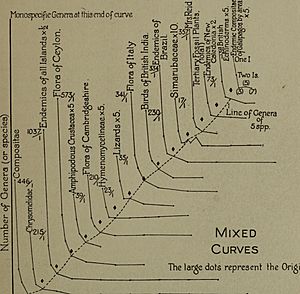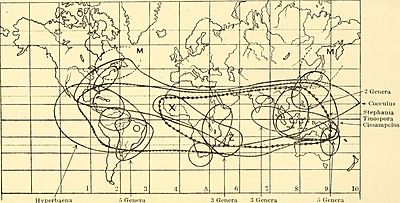John Christopher Willis facts for kids
Quick facts for kids
John Christopher Willis
|
|
|---|---|
| Born | 20 February 1868 |
| Died | 21 March 1958 (aged 90) |
| Alma mater | |
| Awards |
|
| Scientific career | |
| Fields | Botany |
| Institutions | Royal Botanical Gardens, Peradeniya |
John Christopher Willis (born February 20, 1868 – died March 21, 1958) was an English botanist. He is famous for his "Age and Area" idea and for questioning the theory of natural selection.
Contents
Early Life and Learning
John Christopher Willis was born in Liverpool, England. He studied Biology at University College, Liverpool. Later, he studied Botany at Gonville and Caius College, Cambridge.
His Work and Discoveries
In 1896, Willis became the director of the Royal Botanical Gardens, Peradeniya in Sri Lanka (which was then called Ceylon). He worked there until 1912. After that, he became the director of the botanic gardens in Rio de Janeiro, Brazil.
He was recognized for his important work. In 1897, he became a Fellow of the Linnean Society. In 1919, he became a Fellow of the Royal Society.
Willis wrote several important books. These include "A Manual and Dictionary of the Flowering Plants and Ferns" and "Age and Area: A Study of Geographical Distribution and Origin of Species," which came out in 1922.
He moved back to Cambridge in 1915. Later, he lived in Montreux, Switzerland. Willis passed away in 1958 when he was 90 years old. After his death, he received the Darwin–Wallace Medal from the Linnean Society.
In 1901, a botanist named Johannes Eugenius Bülow Warming named a group of flowering plants, Willisia, after John Christopher Willis. These plants are found in India and Bangladesh.
The Age and Area Idea
Willis developed his "Age and Area" idea while studying plants in Ceylon. He looked closely at how different plants were spread out across the land.
His idea suggests that the size of the area where a species lives can tell us how old that species is. He believed that older species would generally be found in larger areas.
Willis also thought that species rarely die out completely. Instead, he believed that new forms of life appear through sudden changes called mutations. He didn't think that local changes through natural selection were the main way new species formed.
He explained his idea like this:
The area a group of similar species occupies depends mostly on how old those species are. However, things like oceans, rivers, mountains, climate changes, or human actions can greatly change this area.
Some scientists supported Willis's idea, like the Dutch botanist Hugo de Vries. But others disagreed. The American palaeontologist Edward W. Berry said that fossil evidence didn't support it. Edmund W. Sinnott also disagreed, saying that other things besides age affect where a species lives. He thought factors like how tough a plant is or how well it can adapt were important.
Willis published his book Age and Area. A Study in Geographical Distribution and Origin of Species in 1922. In 1923, an American entomologist named Philip P. Calvert found examples of insect distribution that didn't fit Willis's idea.
In 1924, Edward W. Berry wrote more about his disagreement:
Willis's ideas are complicated. He makes many claims that can't be proven. He says that where a plant or animal lives depends only on how long it has existed. It doesn't depend on how well it produces seeds or how tough it is. He doesn't believe in things like adaptation or natural selection.
Another American botanist, Merritt Lyndon Fernald, wrote in 1924 that studies of plants in the northern hemisphere didn't support the Age and Area idea.
Willis responded to these early criticisms. He said that scientists like Berry and Sinnott had misunderstood his idea. He explained that his hypothesis should be used for groups of related species, not just single ones. He also said that no other idea could explain the plant data as well as his. He even claimed his idea successfully predicted plant distribution in New Zealand.
The American ecologist H. A. Gleason thought the idea was good because it could be tested. However, he concluded that it couldn't explain how forests move over time. In 1926, Willis wrote another paper defending his idea. But over time, most scientists did not accept the Age and Area hypothesis.
How Evolution Happens
Willis published another important book in 1940 called The Course of Evolution by Differentiation Or Divergent Mutation Rather Than by Selection. This book was a follow-up to his Age and Area work.
In this book, Willis questioned whether natural selection (where the fittest survive) was the main way evolution happened. Instead, he believed that mutations, which are sudden changes in genes, were the most important part of evolution. He thought that changes in chromosomes (parts of cells that carry genes) were largely responsible for these mutations.
He disagreed with Darwin's idea of gradualism, which says evolution happens slowly over a long time. Willis preferred the idea of saltational evolution, meaning big, sudden changes.
Some scientists reviewed his book. Carl Leavitt Hubbs, an American fish expert, said that Willis was suggesting a type of orthogenesis. This is the idea that evolution follows a specific path, almost like it's being pushed in a certain direction.



